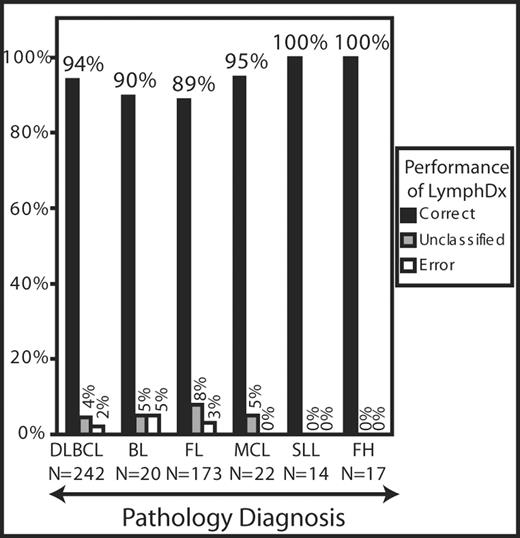Abstract
Clinical management differs significantly for the various types of non-Hodgkin lymphoma (NHL), and the diagnosis of these lymphomas can be challenging in some cases. Further, existing NHL categories include subgroups that can differ substantially in gene expression, response to therapy and overall survival. We have created a custom oligonucleotide microarray, named LymphDx, which could prove clinically useful for molecular diagnosis and outcome prediction in NHL. Biopsy specimens were obtained from 559 patients with a variety of lymphomas and lymphoproliferative conditions. Gene expression profiles of these samples were obtained using Affymetrix U133 A and B microarrays. The 2653 genes on LymphDx were chosen to include:(1)Genes most differentially expressed among NHL types based on Affymetrix U133 or Lymphochip microarrays (2)Genes predicting length of survival in diffuse large B cell lymphoma(DLBCL), follicular lymphoma(FL) and mantle cell lymphoma(MCL) (3)Genes encoded in the EBV and HHV-8 viral genomes (4)Genes encoding all known surface markers, kinases, cytokines and their receptors, as well as oncogenes, tumor suppressors, and other genes relevant to lymphoma. The LymphDx microarray was used to profile gene expression in 434 biopsy samples. These data were used to create a diagnostic algorithm that can distinguish various NHL types and benign follicular hyperplasia(FH) based on gene expression. The algorithm classifies a sample into one of the following categories: Burkitt’s lymphoma(BL), DLBCL, FL, MCL, small lymphocytic lymphoma(SLL) or FH. The algorithm further distinguishes the 3 recognized DLBCL subgroups: germinal center B cell-like, activated B cell-like or primary mediastinal lymphoma. Using a leave one out, cross validation strategy, the algorithm was found to agree well with the pathology diagnosis (see Figure). Some samples were deemed unclassified when their gene expression did not adequately match with that of any of the NHL categories. For a few samples, the gene expression-based diagnosis and the pathology diagnosis were discordant. Pathology review showed that two NHL types coexisted (eg FL and DLBCL) in many of these cases, potentially explaining the results of the diagnostic algorithm. LymphDx could also reliably predict the overall survival of patients with DLBCL, FL and MCL. Prospective evaluation of the LymphDx microarray is warranted since it could be used to provide objective molecular diagnostic, and prognostic information for patients with NHL.
Author notes
Corresponding author


This feature is available to Subscribers Only
Sign In or Create an Account Close Modal